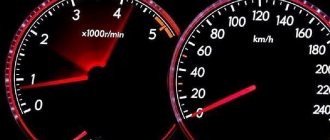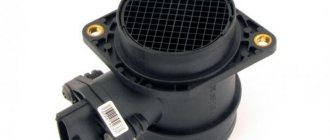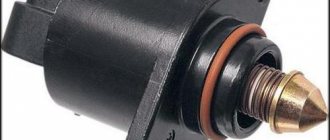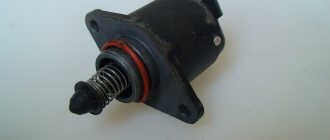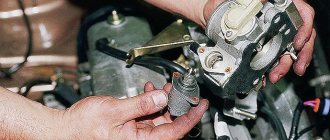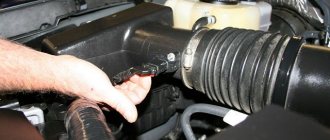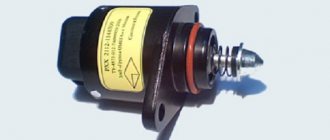The VAZ 2110 is equipped with a 1.5 and 1.6 liter injection engine. As you know, a large number of different sensors are used to operate the injector. Correct operation of the injector is achieved by accurate readings and frequency of the entire system. Often, VAZ 2110 owners are faced with the problem of floating idle speed; it is quite difficult to overcome such a reason without knowing the main reasons, and not everyone can afford to pay for expensive diagnostics.
After studying this article, you can easily find the reason for the floating idle speed on the VAZ 2110. All the reasons why the top ten does not maintain stable speed are described here in detail.
Why does the VAZ 2110 speed fluctuate?
There are several typical reasons why XX does not maintain stable speed.
- Idle air control;
- Throttle position sensor;
- Mass air flow sensor;
- Injectors;
- Filter;
- Air leak;
As you can see, there are not many reasons for this problem, but they all have a significant impact on the operation of the engine. Let's look at each of the reasons in more detail.
Idle speed control
This sensor is installed in the throttle body of the car and serves to open and close the air supply channel necessary for idling. It is a motor that operates on direct current and has a shaft with a worm gear on which a cone valve is mounted. The valve regulates the air supply in the required proportions for stable operation of the internal combustion engine at idle.
Quite often, the IAC jams, which leads to incorrect formation of the fuel mixture at idle, which is why the speed begins to float and engine operation becomes unstable. If you find such a problem on your car, you must first check the IAC.
It is also worth paying special attention to the sealing ring; it very often loses its physical properties and begins to let air through, which also leads to unstable operation of the internal combustion engine.
Damper position sensor
It is installed on the throttle assembly, like the IAC. Responsible for indicating the opening angle of the damper. If it breaks down, the idle speed can spontaneously jump to 2500 rpm and immediately drop to 500 rpm. This occurs due to rubbing of the contact part inside the sensor; this problem is “cured” by replacing the TPS with a new one, since its price is low.
Mass air flow sensor
This sensor is located on the air filter box. When it becomes dirty or aging, it quite often transmits incorrect readings to the engine control unit, which leads to unstable operation of the internal combustion engine. The cost of the sensor is steep, so it is recommended to remove the sensor from a working car and try to install it on your own.
Injectors
Injectors are quite picky about the quality of fuel; during operation, the injector sprays fuel in the required proportions. When contaminated, the injector spray becomes uneven, which leads to incorrect mixing of fuel with air and, consequently, to floating idle speed. This problem can be corrected by flushing the injectors.
Filter
Fuel and air filters directly affect engine performance. If a dirty air filter on a car can significantly reduce the power of a car engine, then chewed fuel filters lead to unstable operation of the internal combustion engine in all its operating modes. It is recommended to replace fuel filters at least once a year.
Air leak
The most extensive and problematic breakdown in a car is solved. Solving this problem is not easy due to the difficulty of detecting the source of the leak. The tightness of the car system must be absolutely everywhere. If air leaks appear somewhere that is not taken into account by the mass air flow sensor (i.e. after the sensor), this leads to unstable operation of the internal combustion engine.
You can check the car for air leaks by unscrewing the mass air flow sensor from the air filter box and turning off the air supply with the engine running. A working car should stall, and the rubber corrugation should compress and remain in a compressed position for quite a long time. If the corrugation immediately straightens out, this indicates an air leak in the system, which clearly leads to floating idle speed of the VAZ 2110.
Which IAC sensor to choose for replacement?
2112.1148300-04 was installed on cars 2110-12 . If for some reason you cannot buy a factory one, you can install an analogue sensor from other manufacturers.
- РХХ /2110-12/ engineer. (2112.1148300-04) factory (KZTA, Kaluga) price from 600 rub.
- РХХ /2110-12/ engineer. FENOX SIP10100O7 price from 300 rub.
- РХХ /2110-12/ engineer. HOFER HF 750381 price from 250 rub.
- РХХ /2110-12/ engineer. MANOVER MR-2112-1148 price from 350 rub.
- РХХ /2110-12/ engineer. StartVOLT VSM 0112 price from 450 rub.
Idle speed of VAZ 2106: do-it-yourself adjustment
If your car starts to stall at idle, then the fuel filter needs to be properly adjusted or cleaned. More details can be found during disassembly.
If the fuel filter is clean, then the reason remains in the idle speed adjustment on the VAZ 2106. In this article we will tell you in detail how to do everything yourself.
Diagram of the VAZ 2106 carburetor idle system
1 – throttle body; 2 – throttle valve of the first chamber; 3 – holes for transition modes; 4 – hole, adjustable with a screw for the amount of mixture; 5 – air supply channel; 6 – adjusting screw for the amount of mixture; 7 – adjusting screw for the composition (quality) of the mixture; 8 – emulsion channel of the idle system; 9 – additional air adjusting screw*; 10 – carburetor body cover; 11 – air jet of the idle system; 12 – idle fuel jet housing with shut-off valve; 13 – fuel channel of the idle system; 14 – emulsion well.
Do-it-yourself idle speed adjustment on a VAZ 2106
1. The idle system is adjusted to ensure stable engine speed at idle with a minimum content of carbon monoxide (CO) and hydrocarbons (CH) in the exhaust gases. We recommend carrying out this operation at the “CO-CH” adjustment points.
2. To adjust the idle speed, the carburetor has a quantity screw, which reduces or increases the amount of mixture entering the engine, and a quality screw, which determines the composition of the mixture.
3. At the factory, restrictive plastic bushings are pressed onto these screws.
4. They do not allow you to violate factory settings. The mixture quantity screw with the limiting bushing can be turned no more than 90°, and the quality screw - by 50°, which allows, without a gas analyzer, only to adjust the idle speed. If it is not possible to adjust the idle speed with the bushings, break them with a screwdriver and repeat the operation.
5. The adjustment is carried out using a gas analyzer on an engine warmed up to operating temperature with the ignition and clearances in the valve drive adjusted (see the relevant sections), with the air damper fully open.
6. Using the quantity screw, set the crankshaft speed on the tachometer to 820–900 rpm.
7. Use the quantity screw to restore the crankshaft speed to 820–900 min-1. If necessary, use the quality screw to restore the CO concentration to 0.5–1.2%.
8. Using the quality screw, achieve the CO concentration in the exhaust gases within 0.5–1.2% at a given position of the quantity screw.
Self-adjustment of idle speed on a VAZ 2106 has been successfully completed. In our other article you can read about the reasons why engine idle speed fluctuates. Enjoy your car ride!
Main reasons
As noted above, there are many factors that ensure the occurrence of the characteristic in question. For example, instability of speed when idling is on can provoke failure of the mass air flow sensor.
Sensors can also be “naughty”:
- speed;
- throttle position;
- crankshaft
Next, we will consider all the options in more detail.
How stable the VAZ-2110 operates largely depends on the correct functioning of the mass air flow sensor, because it is responsible for creating the optimal fuel-oxygen mixture. Device failure is caused by excess fuel or air. Regardless of this, starting the power plant in normal mode becomes impossible.
Signs of a malfunction of the mass air flow sensor are as follows:
- fuel is consumed more actively and usually with less efficiency;
- the engine starts unstably or does not respond to the starter at all;
- the motor malfunctions while driving;
- when the vehicle is idling, the revs fluctuate.
It is not difficult to make sure that the problem is in this sensor. For this:
- turn on the ignition of your VAZ-2110 car (but not the engine);
- take a multimeter;
- set its scale to DCV 20 volts;
- find the mass air flow sensor (under the hood, at the outlet of the air duct corrugation);
- connect the red probe to the yellow wire or the one located closest to the windshield (pierce the rubber band);
- to green (central) - attach black;
- take readings.
If the multimeter shows from 0.99 to 1.03 volts, then everything is in order with the sensor. Otherwise it is changed.
Cleaning DXX
You cannot ignore such a basic procedure as cleaning - this can give results, since sometimes parts of the product, contacts, become coked, covered with dirt and oil.
What you need for cleaning:
- cleaner (lubricant) WD-40 or similar cleaning products for equipment;
- cotton wool, clean rags, tampons.
Cleaning:
- The sensor is completely dismantled, with the block disconnected.
- The swab is moistened with the cleaning mixture. You can also spray the product with an aerosol.
- Carefully wipe the contacts, needle, and installation sites, especially if oil is found there.
Before installation, the regulator is dried, the protrusion of the needle from the body is measured (the norm is 23 mm).
If the sensor has a malfunction of the electrical part - the winding, the electric motor - then repair is impractical or impossible. They buy a new product, especially since it is not too expensive (on average 500–700 rubles, but can be found for 250–300 rubles).
If the problem is in the block with wires (you can buy a new one), loose contacts or contamination, then repair is advisable. Repair also makes sense if there are serviceable parts of an identical product - you can disassemble it and try to replace these parts. But we must take into account that usually such a repaired device breaks down more often and the inconvenience caused by this will be very unpleasant, so it is usually more profitable to immediately buy a new product.
Methodology for finding problems on domestic carburetor systems
Before you start troubleshooting, you need to check that the carburetor is adjusted correctly. The manufacturer sets the settings for ideal operating conditions - the amount of oxygen in the atmosphere of flat terrain and gasoline that complies with GOST. And this is on a new car.
In reality, periodic adjustment of all 4-5 carburetor adjustment screws is required. At least two of them are responsible for stable idle operation. The adjustment is made with the engine running using a simple screwdriver.
The procedure is described in the owner's manual, and differs slightly depending on the carburetor model. The main condition for correct tuning is the absence of leaks, a clean air filter, and high-quality gasoline. The amount of oxygen in the air corresponds to daily use. That is, if you live on a plain, there is no point in adjusting the carburetor while climbing a mountain serpentine to an altitude of 800 meters above sea level.
- Warm up the engine to a temperature of 90°C. If there is no thermometer, the degree of heating can be easily determined by the opening of the cooling system thermostat;
- We start the engine, give a small load - turn on the headlights and the climate system (without air conditioning). Each type of carburetor has its own idle speed, let’s take 750-800 rpm as a basis, as on Solex. The idle speed is controlled by the “quantity” and “quality” screws of the mixture. It will not be possible to establish normal speed with wine alone;
- The forced choke lever (choke) is closed;
- Using the “quality” screw, we adjust the speed to the maximum possible value. As a rule, the screw is fixed at the factory and closed with a plug. It needs to be removed;
- Next, using a standard (on the dashboard) or remote tachometer, set the speed to 900, turning only the “quantity” screw;
- Then use the “quality” screw to set the required value: 750-800 rpm.
Afterwards, you need to start the engine in normal mode, make a test drive, and accelerate in neutral several times to the maximum speed. Then turn off the engine, and after a couple of minutes start it again and check the number of revolutions at idle with a load (high beam + heater). If necessary, repeat the adjustment process.
Causes of malfunction
Floating engine speed shown on the dashboard
It’s not just that the speed in a car starts to fluctuate; this is due to the operation of many systems. Before we begin to consider the reasons, it is worth noting that with such an effect the check may light up or not, but as practice shows, the outcome of the reasons is the same.
Let's consider the main problems of the occurrence of floating speed at idle according to the practice of car enthusiasts and service manuals:
Method for eliminating floating speed on a 16-valve VAZ-2112
Before we move on to eliminating the causes, it is worth noting that untimely repairs can lead to the engine reaching the “start-stop” effect. This means that the engine will start and immediately stall at idle. Therefore, at the slightest occurrence of floating speed, it is worth eliminating the problem. So, let's move on to the actual repair.
Fuel system and everything connected with it
The effect of floating idle speed can occur due to intermittent injection. On older carburetor cars this happens quite often, especially during and after winter. So, to eliminate the causes on the VAZ-2112, it is necessary to perform the following operations:
- Check the operation of the gasoline pump, repair or replace if necessary.
- Replace the fuel filter, which may be clogged due to poor quality fuel.
- Check and clean injection nozzles. If necessary, replace faulty injectors.
- Check the fuel rail for leaks.
- Carry out diagnostics of injector wiring.
If the cause is found, then you should check whether the effect of floating speed has disappeared; if not, then examine the remaining systems.
General view and diagram of the fuel system
Ignition
The car's ignition plays a very important role in setting the speed. It is worth noting that a malfunction of spark plugs (incorrectly selected gap), high-voltage wires or lock can affect the achievement of this effect. Therefore, it is necessary to diagnose these particular components and parts, and, if necessary, replace them.
Replacing the ignition switch can eliminate floating speed
Bad gasoline
Now, the market for fuels and lubricants is quite actively saturated with counterfeits, and therefore even at trusted gas stations you can fill up with low-quality or “bodied” gasoline. This is one of the reasons for floating idle speed. To eliminate the problem, it is necessary to clean the entire fuel system. To do this, do the following operations:
- Remove and then clean the fuel tank.
- Replace the fuel filter.
- Remove the fuel rail and clean the injectors using a special stand.
- Blow out the fuel lines.
- Remove the fuel pump and clean (replace) the coarse strainer.
- Check the condition of the engine cylinders (this is not necessary, but recommended).
Poor quality fuel is one of the reasons for floating speed
Idle speed sensor
Like any engine and electrical part, the idle speed sensor has its own resource and service life, and therefore can fail. It is necessary to unscrew it, carry out diagnostics and, if necessary, replace it with a new one.
The idle speed sensor may be the main cause of floating speed
Throttle
A clogged throttle valve often caused the car to experience the effect that the speed began to float. Therefore, it is necessary to diagnose the condition of this element, and if necessary, clean it.
Throttle valve before and after cleaning
ECU errors
The accumulation of errors in the electronic control unit can lead to various incorrect commands. One of them may be idle speed. So, to fix the problem, you need to connect to the car using a special cable and reset all accumulated errors in the ECU.
Possible ECU error codes
Testing the mass air flow sensor (MAF)
Let us remind you what we are talking about - VAZ-2110 8-valve injector: the speed drops and stalls. A reasonable question arises: what to do? If the reason is not the IAC, then it is worth testing the mass air flow sensor. Here are some recommendations on how to do this:
- Disconnect the sensor connector from the on-board system. The controller that controls the engine will operate in emergency mode, but for short testing this is not fatal. If your car runs much faster, then the problem is most likely in the mass air flow sensor. It's time to clean it.
- Replace the sensor with a working one, and then see how the engine works. There are improvements, which means you need to either clean or replace your own mass air flow sensor.
- It also makes sense to inspect the air intake; to do this, you need to remove the mounting clamp and carefully inspect the inside of the air intake, there should be no condensation or oil there. If any are found, then it will have to be cleaned with special means.
- You can also test the mass air flow sensor using a multimeter. To do this, you need to switch the multimeter to voltmeter mode and set it to 2. The sensor has 2 wires - yellow and green. Yellow transmits a signal to the controller, and green transmits a signal to ground. When the ignition is turned on, we take measurements between these two wires. The engine should not be running. If the readings are in the range of 1.01-1.02, then the sensor is in perfect order. Readings in the range of 1.02-1.03 – it’s time to clean the sensor. And if the indicators go off scale to 1.04, then it’s time to get a new sensor.
Now we have figured out the main symptoms of a malfunction of the mass air flow sensor; neither testing nor troubleshooting is particularly difficult. It is quite possible to cope without after-sales service.
Methods for solving the problem
Before proceeding directly to the process of solving the problem, you need to understand that diagnostics and repair of these components should be performed only with knowledge of the matter. Also, it is worth separately noting that for a carburetor and injection engine there will be different diagnostic methods, but the principle of the causes is the same.
So, it is worthwhile to consistently understand the diagnostic and repair work that will eliminate high idle speed.
IAC sensor
It is not often possible to find an idle air control sensor on carburetor engines. This is usually done using a quality and quantity screw. To normalize high idle speeds, you should not carry out the process cold. First, you should warm up the engine to operating temperature, and only then begin adjustments. If after making the adjustments the speed remains high, then the reason is different.
TPDZ
The wrong amount of air entering the combustion chamber can cause the ECU to over-idle. If the throttle position sensor is faulty, it must also be checked. This can be done with a multimeter or oscilloscope. If it is discovered that the TPS is faulty, it is worth replacing it.
Throttle valve
A stuck throttle can cause a large amount of air to enter the engine. This fact will force the electronic control unit to increase the amount of fuel injected to balance the mixture. This will increase the fuel consumption and accordingly.
In order to solve the problem, it is necessary to dismantle the unit and clean it using special means. If cleaning does not give the desired result, the throttle must be replaced, but you should be prepared that this will not be cheap.
Motor temperature sensor
A failure of the temperature sensor can lead to many problems. One of these will be an increase in idle speed. Typically, as practice shows, this sensor is the most vulnerable and most often fails because it is exposed to temperature changes.
First, it’s worth diagnosing the health of the unit. This can be done using a multimeter and an oscilloscope. If the unit is faulty, it should be replaced. After this, it is recommended to reset all ECU errors.
Collector
Often, due to the use of the vehicle, the intake manifold becomes deformed or the gasket wears out. Thus, an increase in idle speed may indicate that there is an air leak in the manifold. To treat the malfunction, you will have to dismantle the part, which is quite problematic, since almost the entire injection system and several components of other systems are attached to the manifold.
It is worth examining the manifold gasket in detail; the presence of damage may indicate not only problems with speed, but also other malfunctions. Also, deformation of the cavity can cause excess air to enter the combustion chambers. This can affect warming up, engine starting and other factors.
To fix the problem, you will have to grind the surface of the collector until it is smooth. In car services, this is done using a special machine. Of course, you can carry out the process in a garage, using a special stone, but this is not always possible for car owners.
Electronic control unit
Repeatedly high idle speed is a consequence of incorrect operation of the electronic control unit. So, to troubleshoot a problem, you will have to connect to the “brains” and fix the problem at the software level. To complete the process you will need a special cable and software.
But simply resetting errors does not always help; you often have to change the software in order for all the problems to finally go away. It is recommended to trust this process to masters who are professionals in their field.
Along with replacing the firmware, you can increase the power characteristics, which is also recommended to be entrusted to specialists. As practice shows, most car enthusiasts, when independently tampering with the ECU, end up in a car service center to eliminate the consequences of their own modifications.
What do you need to know before adjusting your engine carburetor?
First, we should consider the simplest rules that we will need before proceeding with the operation of setting up this engine unit.
Adjusting the idle speed should only be done when the engine is warmed up to operating temperature. This is an elementary and fairly understandable rule, which can be explained very simply - when an engine adjusted in a cold state heats up, it will work differently. In general, the quality of any carburetor and its reliability are determined by how long it has been in operation. The new reliable carburetor does not require intervention in its operation. Adjustments are made only after the crankcase tube has been completely disconnected. This is the only way to get rid of the influence of crater gases when making adjustments. For precise tuning, you need to use a gas analyzer. This is a desirable but mandatory requirement; however, with the device, the results will definitely be more accurate. The method of regulating the stroke of carburetors is the same for all VAZ cars. You will need one tool - a slotted screwdriver.
The essence of the adjustment procedure is simple and clear. There are two screws on the engine carburetor - they are called the “quality” screw and the “quantity” screw. The first screw changes the area of the hole, through which a mixture of gasoline and air is supplied to the engine. And the quantity screw regulates the crankshaft speed.
There are imported carburetors that use a “quality” screw to change the cross-section of the jet, what is called “by air”. You can tell them apart by looking at the “quality” screw at the top of the carburetor. On domestic fuel supply systems, this screw is located at the bottom of the unit - the usual “gasoline” setting.
To finish with the theory and start talking about how the engine idle speed is adjusted, let’s just say that when tuning “by air,” the air-fuel mixture is enriched with gasoline, and when tuning “by gasoline,” on the contrary, it becomes leaner. Also, those interested can look at the picture explaining the principle of operation of the carburetor.
Possible reasons
There are a number of reasons why the VAZ 2114 idle floats:
- one of the sensors that regulate engine operation is faulty (these include sensors: idle speed, air flow, throttle position, crankshaft position, speed sensor);
- the air filter is damaged or dirty;
- spark plugs are faulty;
- armored wires are damaged;
- the gaskets sealing the connection of the manifold working on the inlet with the cylinder head are damaged;
- EGR valve is faulty.
Due to such a large number of possible malfunctions, the search should be carried out systematically and in order, starting with the most likely causes.
Checking the serviceability of the throttle position sensor (TPS)
Our problem may be caused by a faulty DPSD. But it is this sensor that is tested last, when everything has been tried and tested. But in vain, it is easy to test, you can save a lot of time and money if you check this sensor. How to do it:
This sensor is located on the throttle pipe, it is connected to the throttle axis. The sensor is secured with two screws
When removing the sensor, you should pay attention to the condition of the throttle valve, whether it is coked. If yes, then there will be the same symptoms as with problems with the sensor
However, the sensor can be checked without removing it. To do this, you need to measure the voltage at the DPZD terminals when you turn on the ignition, and it should not exceed 0.7 V. Next, open the throttle using a plastic sector, and then measure the voltage again. It must be at least 4 V. Next, check the voltage at the terminals of the DPSD when the damper moves. It should not change; abrupt changes indicate a sensor malfunction.
Having found out that the sensor is faulty, it should be replaced. On the VAZ-2110, 2 types of DPZD are installed - film-resistive and non-contact. The first is designed for 55 thousand mileage, the second is unlimited, but much more expensive than the first.
Well, dear friends, we have presented some tips for servicing your car yourself. I hope you find them useful.


